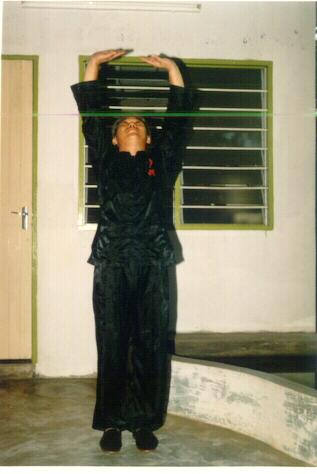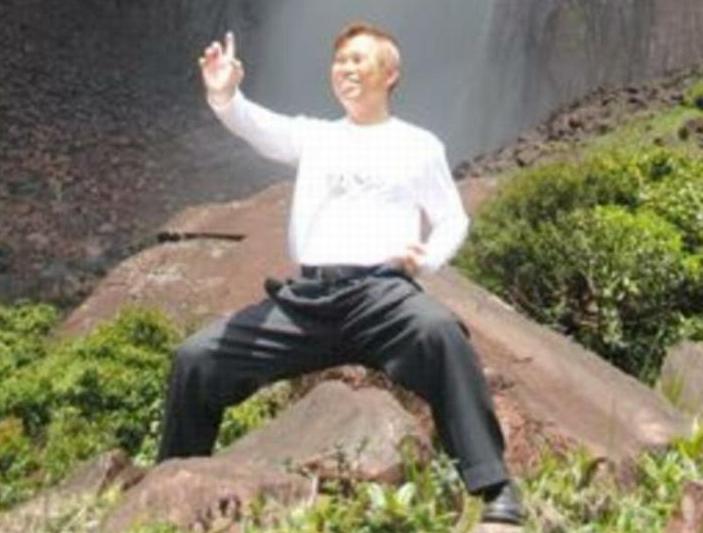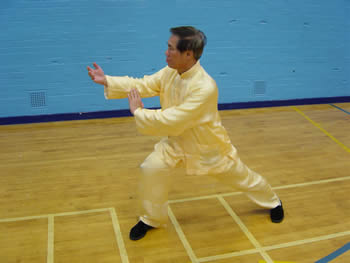SENSITIVITY AND OTHER BENEFITS FROM ASKING BRIDGE

An old picture showing Grandmaster Wong performing "Lifting the Sky"
Question
Asking Bridge helps to develop sensitivity. Which chi-kung exercise and which internal-force exercise would be the most complimentary to help develop sensitivity?
Sifu Anton Schmick
Answer
Besides developing sensitivity, Asking Bridge also develops hand techniques, body movement and footwork. These are called the three external harmonies.
I recall Robin telling me that the Pushing Hands exercise we did at an Intensive Taijiquan Course (Pushing Hands is a part of the Asking Bridge course in Frankfurt in September 2014) was the best footwork training he ever had. He gained so much benefit that he subsequently could easily push even established masters away at a Taijiquan seminar.
Together with the three internal harmonies of jing, qi, shen, or elegance, energy and mind, the three external harmonies of body, hands and feet form the six harmonies. Asking Bridge also trains, albeit indirectly, these three internal harmonies. In other words, by practicing Asking Bridge you can improve the elegance of your movement, your control of energy flow, and your presence of mind.
Actually all training can improve the six harmonies. No matter what we train, we improve our hand techniques, body movement, footwork, elegance of movement, energy flow and presence of mind. But most people are unaware of these six harmonies, hence they miss the benefit of the training. They do not, for example, ensure that they move their techniques elegantly, or have the appropriate stance.
Even some masters and many writers do not know what the six harmonies mean when they talk about them. They just repeat statements like the hands must harmonize with the feet, or their energy must harmonize with their mind, but they may not really know what they are saying. A lot of such repetition of clichés can be found in books and on the internet.
Some examples are as follows. When you deflect an opponent’s punch with “Single Tiger Emerges from Cave”, your False Leg stance must be correct in form as well as in spacing. If your front leg supports too much body weight, or you are too close or too far away, you hands do not harmonize with your feet, even when you hand technique is perfect.
When you perform any technique, your energy flow must be smooth, and you have presence of mind. If you are tensed, thus blocking your energy flow, or you are distracted, your energy does not harmonize with your mind, even when the form of your body, hands and feet is perfect.
When we practice Asking Bridge, we do not just improve our six harmonies, but learn how to respond correctly and spontaneously to an opponent’s attack. Indeed, at the initial stage this is the objective of the training, with the six harmonies as checking points.
In other words, we learn how to use techniques from our art to respond first correctly, then spontaneously to an opponent’s attack. To be cost effective, we structure the attacks in a systematic and progressive way. We check that our body, hands, feet, movement, energy and mind are in harmony.

One-Finger Shooting Zen
Asking Bridge, or Men Kew in Chinese, actually refers to such training in Southern Shaolin or Hoong Ka Kungfu. But in our Asking Bridge course, for lack of a better term, we have expanded the term to include Sticking Hands (Chi Sau) in Wing Choon, Kneading Hands (Cai Sau) in Wuzuquan, and Pushing Hands (Tui Sau) in Taijiquan.
We are able to do so because of our breadth and depth. Most other schools do not have this opportunity. Their students, if they are lucky, can only learn one of these four ingenious training methods. We may have to think of another term to refer to this wide meaning of Asking Bridge, so that this term will refer only to its narrower meaning in Hoong Ka Kungfu.
All chi kung exercises can improve sensitivity, because sensitivity depends on mind and energy, and all chi kung exercises are a training of mind and energy. Chi kung techniques performed as gentle exercise may also improve sensitivity, but to a far lesser extend.
In theory at least, all internal force training exercises can also improve sensitivity, because all internal force training exercises are also chi kung exercises. In practice, many people do not practice internal force training methods as chi kung, or energy art, but as isometric exercise, i.e. physically tensing their muscles and then relaxing them. Isometric exercise also increases force, but does not improve sensitivity.
There are two main approaches in internal force training, namely flowing and consolidating. Flowing force will improve sensitivity more than consolidating force.
Of the chi kung exercises, the most complimentary to developing sensitivity is Chi Flow in Bone Marrow Cleansing at the Skin Level.
If we use the term “chi kung” in a narrow sense so as to differentiate “chi kung exercises” from “internal force exercise”, the most complimentary chi kung exercise to generate a chi flow at the skin level to help develop sensitivity, in my opinion, is Lifting the Sky.
The most complimentary “internal force exercise”, in my opinion, to generate a chi flow at the skin level to help develop sensitivity is Grasping Sparrow’s Tail. Lifting Water is also an excellent “internal force exercise”, but Grasping Sparrow’s Tail has a slight advantage that it is mobile. Moreover, the internal force generated in Grasping Sparrow’s Tail is relatively more flowing.
In my own experience, the “internal force exercise” that has most enhanced my sensitivity is One-Finger Shooting Zen. Many students were surprised that while explaining a crucial point in class but a sparring partner continued to attack me, I could deflect the attack correctly and spontaneously without looking at it. On hindsight, this high level of sensitivity was developed through my dedicated practice of One-Finger Shooting Zen.

Grasping Sparrow's Tail
Four Sequences of Asking Bridge
Glimpse of Asking Bridge, Saariselka 2011
Treasure House of Kungfu Sets
Treasure House of Combat Application
Those who wish to attend the 18-Lohan Fist course in Frankfurt, Germany on 26th, 29th, 30th September and 1st October 2014, please contact Secretary, Wahnam Germany or phone (069) 904-31954.
The questions and answers are reproduced from the thread 10 Questions on Asking Bridge in the Shaolin Wahnam Discussion Forum.
LINKS
